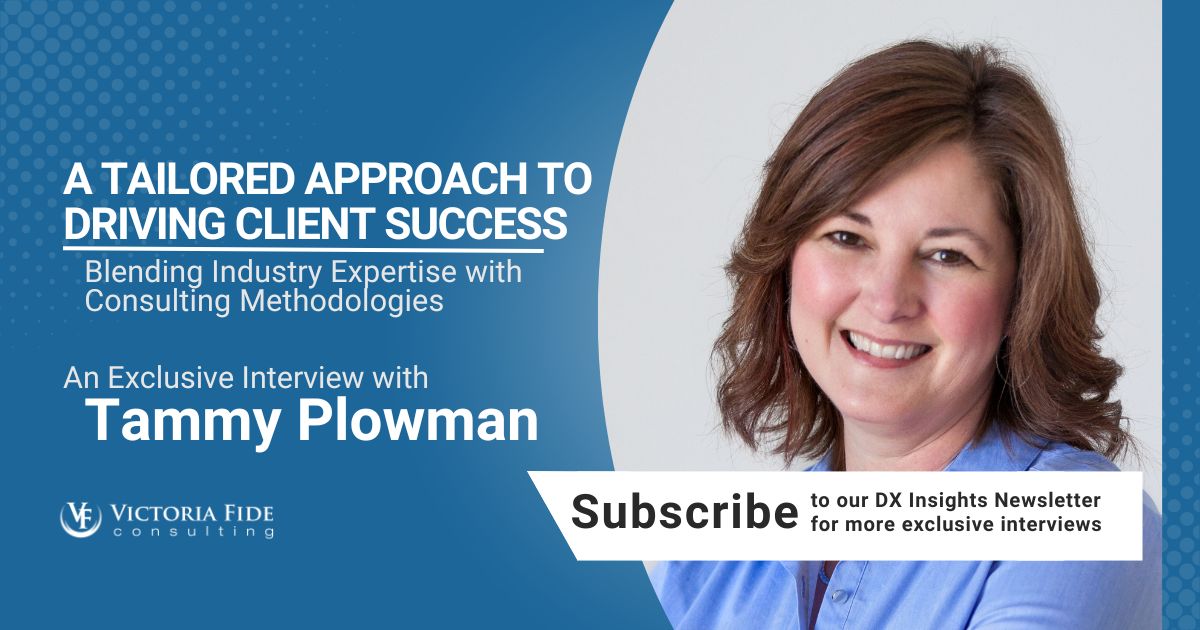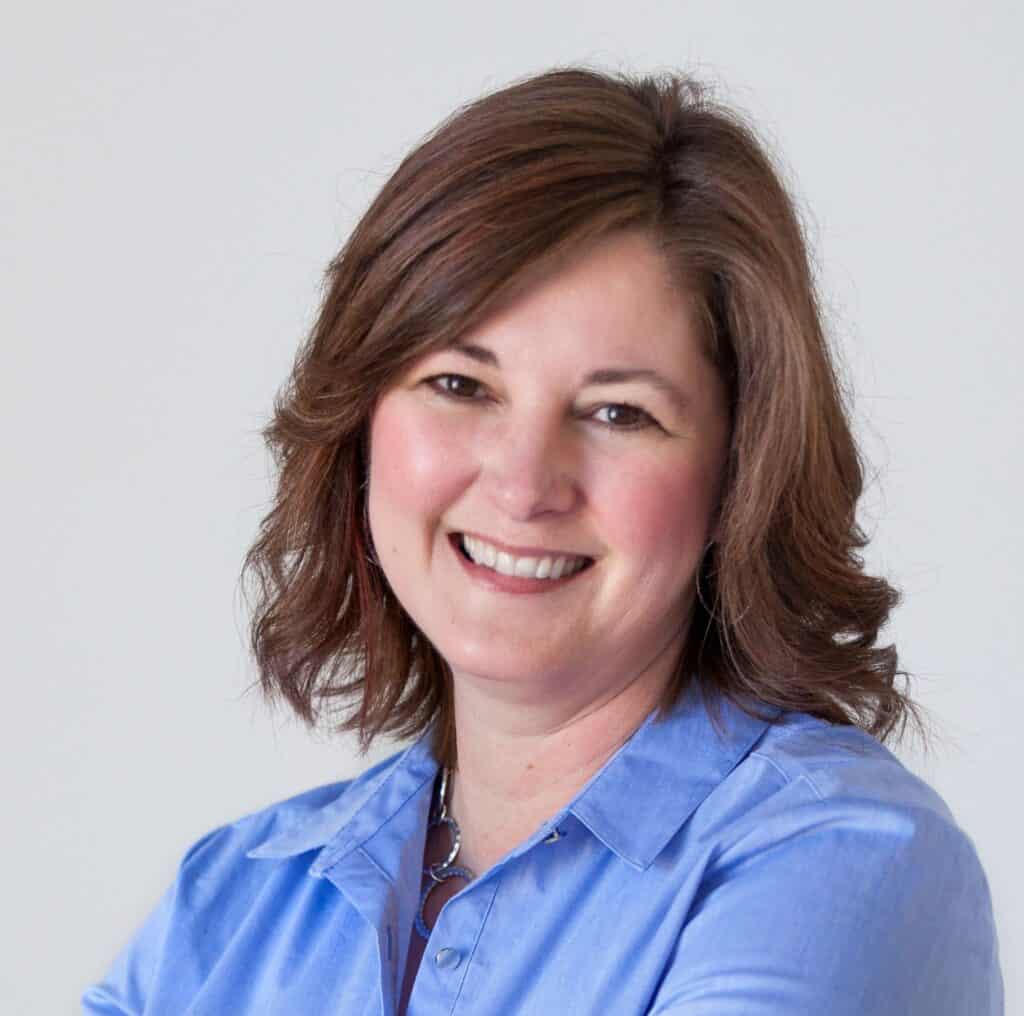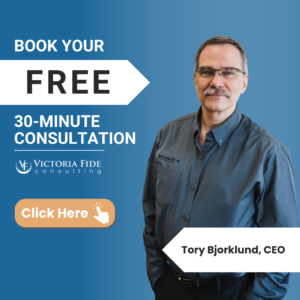

Tammy Plowman is a Solution Architect at Victoria Fide Consulting. With twenty years dedicated to manufacturing and distribution, she has managed procurement, finance and accounting, inventory control and costing, process improvements, and system implementations. In 2015, Tammy became a full-time functional consultant. She has worked with 49 clients in the Microsoft Dynamics solutions space and served in a variety of roles from Support Engineer to Solution Delivery Manager.
Tammy enjoys being a catalyst of change when partnering with clients to understand and assist them in their journey to better business processes and systems. With her tenacious curiosity and energetic problem-solving skills, she can break down complex problems into manageable ones. Her greatest strength is her hands-on industry expertise paired with her passion for driving client success. In this interview, Tammy reveals her double-edged approach to client success by blending her industry expertise with reliable consulting methodologies.
Read on to learn about the common pitfalls of implementations and strategies for overcoming them by utilizing active listening, change management tactics and a little bit of creativity. Tammy shares how her passion for exploration fuels her drive for innovation and learning, how she uses communication to foster transparency, trust and engagement with stakeholders, and how she channels her curiosity into tangible solutions that provide immense value for her clients.
Table of Contents
Q. Can you share a particularly challenging problem you encountered during your time in manufacturing and distribution, and how your problem-solving skills were instrumental in finding a solution?
One notable challenge in manufacturing was balancing ease of use, material yield variations, and inventory accountability. We faced significant discrepancies between expected and actual yields, impacting inventory accuracy, production costs, and reorder points. Our problem-solving approach involved cross-functional collaboration and honest feedback.
We identified some unexpected root causes and implemented process improvements to minimize yield variations. These process improvements included obtaining the scale weight of remaining raw materials at the end of each production material run. Differences in weight were immediately transferred to a location for further research and follow-up.
With these changes, we had significantly increased visibility to exceptions and could immediately focus on exceptions outside of agreed tolerances. By increasing visibility and fostering a culture of continuous improvement, we achieved a balance between user-friendly processes and more accurate inventory, ultimately improving operational costs and decreasing user frustrations. This experience underscored the importance of holistic problem-solving and collaboration in addressing business challenges.
Q. Given your transition from industry roles to consulting, how do you leverage your previous experience to better understand and address the needs of your clients?
My previous experience serves as a foundation for truly understanding and addressing my clients’ needs. Having worked firsthand in various sectors, I possess invaluable insights into the challenges, dynamics, and intricacies of these industries. This allows me to empathize with my clients’ perspectives and tailor solutions that resonate with their team.
Moreover, my industry background equips me with a deep understanding of best practices, trends, and potential pain points within different sectors. By leveraging this knowledge, I can offer guidance that is not only informed by theoretical frameworks but also grounded in practical realities. This enables me to provide actionable recommendations that are realistic and feasible within the client’s own operating environment.
Ultimately, my journey from industry to consulting allows me to blend real-world expertise with consulting methodologies, enabling me to deliver tangible value to my clients by offering practical, tailored solutions that drive sustainable growth and success.

Transformation is not easy, but it doesn’t have to be impossible. Take control of your project’s success today and schedule a free 30-minute consultation to find out how Victoria Fide can equip you for transformational success.
Q. In your experience with process improvements and system implementations, what are some common pitfalls you’ve observed, and how do you navigate them to ensure project success?
In my experience, the most common pitfall during system implementations is users’ tendency to replicate old system functionalities, hindering the adoption of new processes. Typically, clients always know what areas or processes their team is very attached to. We should be very proactive with those areas and invest the time to understand their needs and concerns!
For example, a client was nervous about order entry process changes and liked the current layout of their legacy order entry screen. The first thing I did was to meet with the client’s order entry team and have them show off the current system for order entry. Then we collected a few orders and worked with their team to mirror them in the new operating system, with our primary goal being to build user confidence. The secondary goal was to identify any process gaps and anything that improved their current process.
This type of “hands-on lab” is one of the most effective ways to foster understanding and buy-in from the user community by allowing them to learn and explore with guidance. This also allows us to emphasize the benefits of the new system and often generates genuine excitement. By addressing concerns empathetically and demonstrating the value of change, we mitigate resistance and promote a smoother transition, ensuring project success and maximizing the system’s potential for improvement.
Q. As someone with expertise in Microsoft Dynamics Finance & Operations implementation, how do you balance between leveraging out-of-the-box functionality and designing customizations to meet client requirements?
In a Microsoft Dynamics Finance & Operations implementation, striking the right balance between leveraging out-of-the-box functionality and designing customizations is crucial. Firstly, assess the client’s needs against the platform’s capabilities. Utilize standard features wherever possible to ensure scalability, ease of maintenance, and compatibility with future updates. Customizations should be reserved for unique business processes or critical requirements that standard functionalities cannot meet. Prioritize customization efforts based on necessity, which should correlate to their impact on business outcomes. Then, ensure thorough design documentation and user training to mitigate customization risks.
Sometimes a functionality gap may warrant considering an additional solution integrating with Dynamics. For example, let’s assume our client accepts hundreds of EDI sales orders daily. Their customer base requires immediate notification of any price discrepancies prior to confirming these sales orders, a feature which is not native to Dynamics. Therefore, we would need to explore EDI-related solutions that would fulfill their price comparison requirement while providing a smooth integration with Dynamics. Ultimately, a balanced approach ensures efficient implementation, maximizes ROI, and fosters long-term client satisfaction.
Q. Given your passion for exploring new places and discovering outlets for creativity, how do you incorporate innovation and fresh perspectives into your approach to solving complex business challenges?
My passion for exploring and creativity fuels a constant drive to learn and innovate. I actively seek new ideas from diverse sources to infuse fresh perspectives into problem-solving. Embracing curiosity, I approach complex business challenges as opportunities for growth and discovery.
For instance, creating and maintaining training materials is an arduous task for many of our clients. While we had an enterprise-level recommendation for clients, we did not have a more affordable option that we could recommend. I identified, researched, and trialed twenty-two products before finding a fantastic choice. It was a gratifying exercise for me, learning more about what features clients might be looking for in this type of software. I look for free and low-cost apps that clients can benefit from, and I always try these products out myself before making a recommendation. I’m also not shy about providing feedback on the product, which has sometimes resulted in changes.
It is very rewarding to turn my curiosity about new things into a tangible solution that provides a great deal of value for our clients! By continuously expanding my knowledge and staying open to new possibilities, I ensure that my approach remains dynamic and adaptable, driving innovation and successful outcomes in the face of complexity.
Q. How do you approach stakeholder management and communication when leading clients through various project phases, from planning to post Go Live support?
Clear and consistent communication is critical throughout project phases. Alignment and regular communication begin internally, and our team works together to ensure stakeholders are informed at every step, fostering transparency and trust. I prioritize active listening and understanding their needs and concerns. Often, this leads to adjusting our approach accordingly.
I remember a time where employing active listening enabled us to collaborate on a solution – one that I continue to use today. Sometimes, the terminology of a new system can be anxiety-inducing for clients. I was once pointedly asked, “How will users learn the new processes when they cannot seem to grasp the terminology?” Rather than assuming this would resolve itself over time, we collaborated to assemble a glossary.
We limited the information to a single page, defined the new terminology, and related this to their current system terms. This made a tremendous difference! So much so that I now incorporate definitions as an FAQ sheet for specific business processes such as price management. I am also much more aware of connecting existing and new terminology when communicating.
Regular project check-ins maintain alignment and address any emerging issues as soon as possible. We foster strong partnerships that drive successful project outcomes by prioritizing stakeholder engagement and communication.
Q. With your background in both functional and technical aspects of solution delivery, how do you ensure a holistic understanding of client needs while also maintaining a focus on technical feasibility and implementation efficiency?
Balancing client needs and technical feasibility requires a collaborative approach within our team. This begins with ensuring everyone understands both the client’s requirements and technical constraints. Then, cross-functional meetings allow us to consider fresh ideas and brainstorm solutions that satisfy both aspects. By fostering a culture of mutual respect and knowledge-sharing, we leverage each team member’s expertise to devise holistic solutions that meet client needs while optimizing technical implementation efficiency. This collaborative mindset ensures that our solutions are not only technically sound but also aligned with our client’s overarching objectives.

Crafting Excellence Through Curiosity, Creativity, and Collaboration
Tammy’s integration of a passion for innovation with a pragmatic approach to complex business challenges results in a powerful strategy for addressing clients’ needs effectively and efficiently. Tammy’s experiences reflect a deep understanding of how combining curiosity with a systematic process can lead to innovative, yet feasible, solutions that significantly benefit clients. By placing a high value on stakeholder engagement, continuous learning, and the pursuit of new technologies, we can see how a dynamic approach to problem-solving not only leads to successful project outcomes but also contributes to long-term client satisfaction and loyalty.
Tammy offers valuable lessons in fostering trust and engagement, ensuring project success, and achieving excellence through innovative solutions. Through this balanced and client-focused approach, it is evident that building strong, lasting relationships with clients grounded in mutual trust and respect is a key driver of positive outcomes in the fast-evolving landscape of technology solutions.
